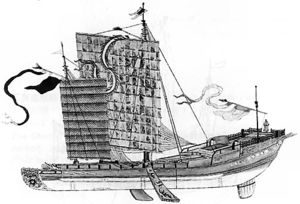

 With current historical
scholarship, none but the most myopically Eurocentric embrace
the myth that Columbus "discovered" America in 1492.
That feat, we now know, was accomplished tens of thousands of
years ago by a small band of Chinese, the ancestors of Native
Americans, who crossed over the Bering Strait into the Western
hemisphere.
With current historical
scholarship, none but the most myopically Eurocentric embrace
the myth that Columbus "discovered" America in 1492.
That feat, we now know, was accomplished tens of thousands of
years ago by a small band of Chinese, the ancestors of Native
Americans, who crossed over the Bering Strait into the Western
hemisphere.
The more we search for the first recorded visits to our Northwest Coast, the more fascinating the mystery becomes. Some years ago a portion of an early chart from the North Pacific was reproduced as the end papers of a book on local history. Outlines of the coast and entries about Spanish and Russian discoveries date it prior to the voyages of Captains Cook and Vancouver. One entry reads "Land which is supposed to be FOU SENG of the Chinese Geographers", this begins about 50° north. Also it is remarked that this is the "Coast seen by the Spanish in 1771 with inhabitants which go naked".
There are other charts with similar details, a Hondius map from 1630 (Dutch) shows a Chinese junk in the area. "Fousang" shows up on other charts and maps, one from 1768 places it near the River of the West and what might be Puget Sound. Other reports of oriental visits and artifacts continue down the coast to Central America and beyond. Needless to say the coastlines and place names of the cartographers of the time are pure fancy, interesting in an historical sense as they show the growing interest in "Terra Incognito" or the last unknown seas and landset to be explored. See map.
But it was in 499, a Chinese Buddhist missionary, Hoei-Shin, came back from a long voyage and told of a strange people in a strange land, 20,000 Chinese miles to the east. That would've put him right on the west coast of the Californians, then part of Mesoamerica.
Hoei-Shin named the place Fusang, after a succulent plant he'd found in that arid land. The natives ate its roots and made wine from its sap. From its thick leaves they made cloth, rope, roof-thatch, and even paper. Hoei-Shin wrote about their society and folkways, all very unlike anything Chinese. Of course, the fusang plant sounds just like the Mexican maguey plant, the Agave americana which served so many functions for the pre-Columbian natives of Mexico.
A French scholar, Deguignes, wrote about Fusang in 1761. A German professor, Neumann, published Hoei-Shin's narrative in 1841 along with a commentary. An American, Charles Leland, translated and expanded Neumann's work in 1875.
According to some historians, the distances given by Hui-Sheng (20,000 Chinese li) would locate Fusang on the west coast of the American continent, when taking the ancient Han-period definition of the Chinese li. The Chinese li, or Chinese mile unit of distance, varied through time, and although it was roughly 435 meters during the Chin and Han dynasties, it was approximately 77 meters under the Wei and Western Qin dynasties, as used as such in the Sanguo Zhi or Records of Three Kingdoms. The description of the plants and people in the strange land led some scholars to suggest that the Chinese had visited America a thousand years before Columbus. Some Chinese and Buddhist artistic influences on the Mayan art of the period have also been suggested.
The very simplicity of that enormous journey is the most convincing argument of all. Since Leland's book, experts have thrashed out the details with little public notice. Anthropologists have found Chinese and Japanese influences and artifacts among Native Americans all the way south to Peru. It appears that what Hoei-Shin was able to do, others probably did as well.
None of this reaches the textbooks. And so we forget. We forget there was a Russian capital on our west coast before the Gold Rush. There was a university in Mexico City before Shakespeare. We forget that, just as the Roman empire fell, Chinese missionaries were preaching to pre-Aztec Mexicans.